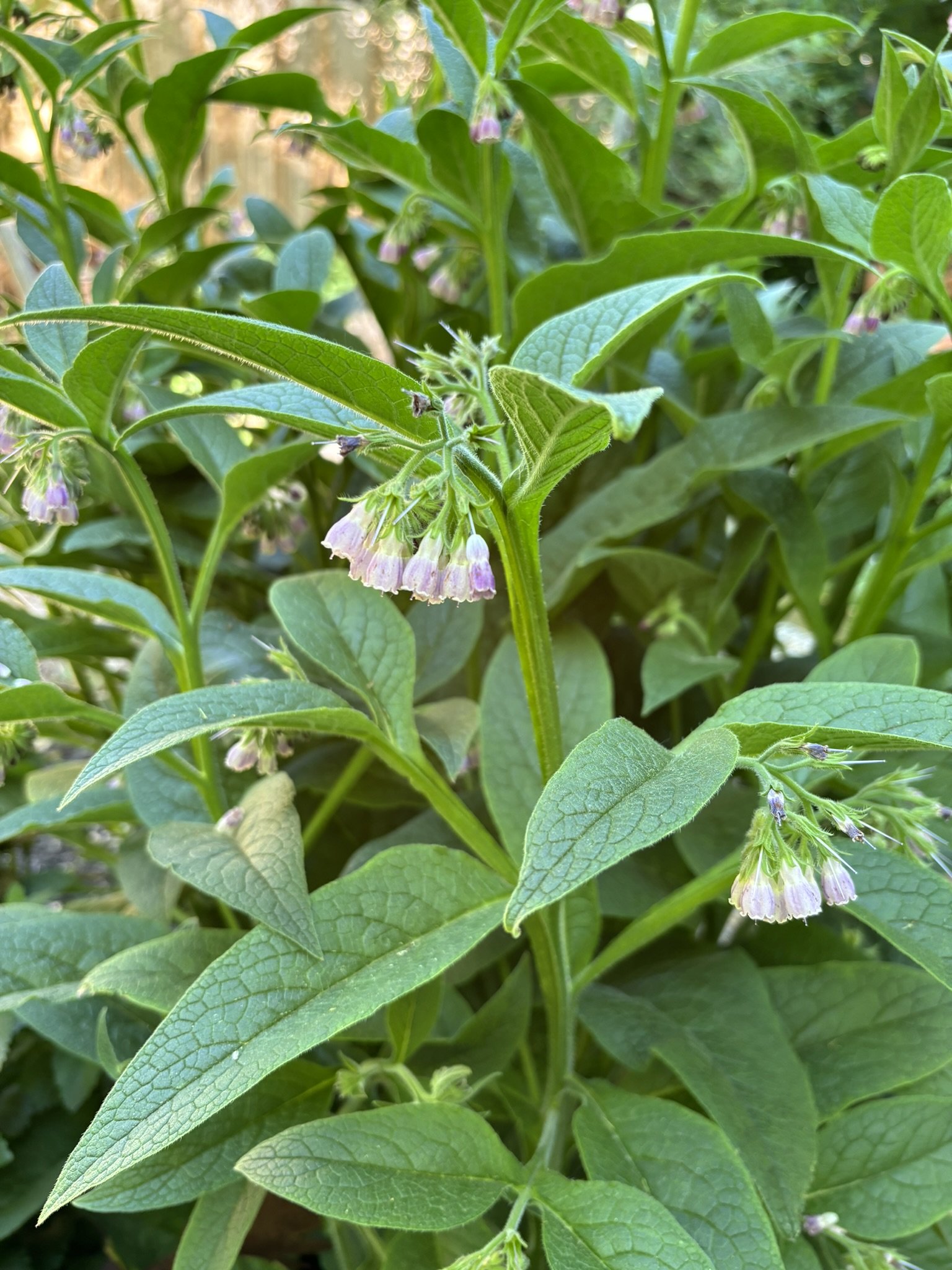Comfrey
Latin Name: Symphytum officinale
Appearance and Habitat
Comfrey (Symphytum officinale) is a robust, perennial herb belonging to the Boraginaceae family. It typically thrives in damp, grassy environments such as riverbanks, ditches, and moist meadows across Europe and parts of Asia, but cultivated it thrives here at Three Leaf Farm. The plant can grow up to three feet in height, featuring large, lance-shaped leaves that are dark green and covered in fine, hair-like structures that make it feel a little scratchy. Its adorable bell-shaped flowers range in color from creamy yellow to purplish blue, blooming in clusters on the upper part of the plant from late spring to early summer.
Medicinal Uses
Comfrey has been valued for its medicinal properties for centuries. Its roots and leaves are rich in allantoin, a compound that promotes the regeneration of cells, making it highly effective in treating wounds, fractures, and skin conditions. Traditionally, comfrey is used externally in the form of poultices, salves, and compresses to reduce inflammation, alleviate pain, and accelerate the healing process of bruises, sprains, and broken bones. Additionally, it is beneficial for treating minor burns and skin ulcers due to its soothing and anti-inflammatory properties. Comfrey is one of the best ingredients for salves for minor wounds, and a single comfrey plant is usually enough for a home pharmacy.
Cultural Significance
In medieval Europe, comfrey was commonly known as "knitbone" for its reputed ability to heal fractures and injuries. Herbalists of the time not only applied it externally but also used it in teas to help treat broken bones and soothe gastrointestinal issues. Across various cultures, comfrey has been a go-to herb for promoting overall health and well-being, symbolizing healing and recovery.
Magical Uses
Comfrey, known for its regenerative properties in gardening, also holds significance in magical practices. Associated with protection, healing, and transformation, comfrey is utilized in spells and rituals for its ability to mend, both physically and spiritually. Its leaves and roots are used to create protective sachets, charm bags, or incense to shield against negative energies and promote emotional healing. Comfrey is also employed in rituals aimed at fostering growth, renewal, and personal transformation, encouraging individuals to embrace change and move forward with strength and resilience.
Contraindications
Despite its numerous benefits, comfrey should be used with caution. The plant contains pyrrolizidine alkaloids, which can be toxic to the liver if ingested in large quantities or over extended periods. Pregnant and breastfeeding women, as well as individuals with liver conditions, should avoid using comfrey altogether. Most herbalists today recommend minimal internal use but may still use the plant during acute broken bone injuries.
Three Leaf Farm Comfrey Salve Recipe
2 cups almond or olive oil
7 large comfrey leaves, chopped small
3 stalks fresh yarrow, chopped small
9 leaves of plantain, chopped small.
2.5 oz beeswax
10 drops tea tree essential oil
1 Tablespoon Vitamin E
In a double boiler, warm the oil with the comfrey, yarrow, and plantain.
Allow the oil to infuse for 2 hrs. Be sure not to let the water run out in the underneath pot, as you don’t want the oil to ‘fry’ the herbs. The warm oil will pull the medicinal compounds from the leaf.
Strain the oil through a double layer of cheesecloth into a glass Pyrex measuring cup.
Measure the remaining oil. Add 2 oz per 1 cup of oil for the salve.
Place the Pyrex dish with the oil and the beeswax in the remaining hot water and turn the heat up high. Add water if necessary, but you don’t want the water in the pot to go above about halfway up the Pyrex measuring cup.
Heat the oil until the beeswax melts. (Alternately, you can always microwave the Pyrex for about 3 minutes to melt it. Some folks don’t like to use microwaves, and some do. It's a personal choice.
Once the beeswax has fully melted, remove the Pyrex from the water bath and allow it to sit for 5 minutes to slightly cool.
Add the Vitamin E and the Tea Tree Essential Oil. Gently stir, (do not stir any air into the oil)
Carefully pour the hot mix into jars.
Cap, label and date.

